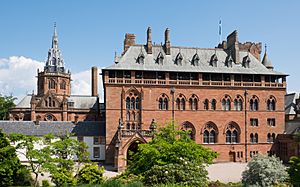Sheina Marshall facts for kids
Quick facts for kids
Sheina Macalister Marshall
|
|
|---|---|
 |
|
| Born | 20 April 1896 Rothesay, Scotland
|
| Died | 7 April 1977 (aged 80) Millport, Scotland
|
| Nationality | Scottish |
| Alma mater | University of Glasgow BSc (1919), DSc (1934) |
| Known for | The study of marine productivity, animal and plant plankton in particular the copepod Calanus |
| Awards | FRSE (1949) FRS (1961) OBE (1966) Neill Prize |
| Scientific career | |
| Fields | marine biology |
| Institutions | Marine Biological Station |
Dr. Sheina Macalister Marshall (born April 20, 1896 – died April 7, 1977) was a Scottish marine biologist. She spent her life studying tiny ocean creatures and plants called plankton. She was a top expert on a specific type of tiny crustacean called a copepod, especially one named Calanus. Dr. Marshall worked at the Marine Biological Station in Millport, Cumbrae, Scotland, from 1922 to 1964.
Contents
Discovering Ocean Life
Sheina Marshall started her career at the Marine Biological Station in Millport in 1922. This is where she worked for most of her life. In 1928 and 1929, she went on an exciting trip. She joined the Great Barrier Reef Expedition, exploring the famous coral reef in Australia.
Studying Plankton and Food Chains
Dr. Marshall's main work was studying the ocean's food chain. She focused a lot on copepods, which are tiny animals that float in the water. For nearly 40 years, she worked closely with a chemist named Andrew Picken Orr.
Together, they studied the small plants (phytoplankton) and animals (zooplankton) living in the river Clyde and Loch Striven. They wrote many important books and scientific papers about their discoveries. Their work helped us understand how these tiny creatures support all life in the ocean.
Helping During World War II
During the Second World War, it was hard to get certain materials from other countries. Dr. Marshall helped find new ways to get agar. Agar is a jelly-like substance used in medicines. She worked with other scientists to find agar in seaweeds around the United Kingdom.
She also looked into how adding fertilizers to water affected how much life grew in places like Loch Craiglin. This research was important for understanding ocean health.
Later Years and Continued Research
Sheina Marshall retired as the Deputy Director of the Millport Station in 1964. Even after retiring, she continued her research there as an Honorary Fellow. This meant she could keep studying the ocean life she loved.
She visited other famous marine stations around the world. In the early 1970s, she went to the Scripps Institution of Oceanography in the United States. Later, in 1974, she visited the Villefranche-sur-Mer Marine Station in France. In 1987, she wrote a book about the history of the Millport Marine Station.
Early Life and Education
Sheina Marshall was born on April 20, 1896, in Rothesay, Scotland. She was one of three daughters. Her father, John Nairn Marshall, was a doctor who loved natural history. He encouraged his daughters to be curious about nature.
Sheina was first taught at home by private teachers. Later, she went to Rothesay Academy and St Margaret's School. In 1914, she started studying at the University of Glasgow. She studied Zoology, botany, and physiology. Her studies were paused because of World War I. She graduated with honors in 1919.
After university, she continued her research at the University of Glasgow. She worked with Professor John Graham Kerr before moving to Millport.
Beyond Science
Outside of her scientific work, Sheina Marshall enjoyed many hobbies. She loved walking, traveling to other countries, and doing needlework. She also enjoyed poetry and music. People described her as a kind, respected, and generous person.
Sheina Marshall passed away on April 7, 1977, from a heart attack. She left her house in Millport to the Directors of the Marine Station.
Her sisters also achieved great things. Margaret Marshall was a Matron at Edinburgh's Royal Infirmary. Dorothy Nairn Marshall was a museum curator on the Isle of Bute.
Awards and Recognition
Sheina Marshall received many important awards for her work.
- In 1949, she and Ethel Dobbie Currie became the first women to be chosen as Fellows of the Royal Society of Edinburgh. This is a very high honor for scientists in Scotland.
- She received the Neill Prize from the Royal Society of Edinburgh in 1971.
- In 1963, she was elected a Fellow of the Royal Society of London. This is one of the oldest and most respected scientific organizations in the world.
- She was awarded the Order of the British Empire (OBE) in 1966. This award recognizes great service to the United Kingdom.
- In 1977, she received an honorary degree from the University of Uppsala in Sweden.
To honor her contributions to science, a teaching building at the Scottish Association for Marine Science was named after her in 2010.
Selected Works
Sheina Marshall wrote over 60 scientific articles and books. Here are a few examples:
- 'The Food of Calanus finmarchicus during 1923', Journal of the Marine Biological Association of the UK, Vol. 12 (1924), 473-79.
- On the Biology of Calanus finmarchicus. VIII., 1955 (with Andrew Picken Orr)
- The Biology of a Marine Copepod, 1955 (with Andrew Picken Orr)
- 'Respiration and Feeding in Copepods', Advances in Marine Biology, 1973
- An account of the Marine Station at Millport, 1987


